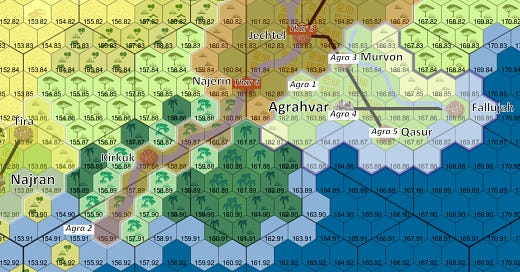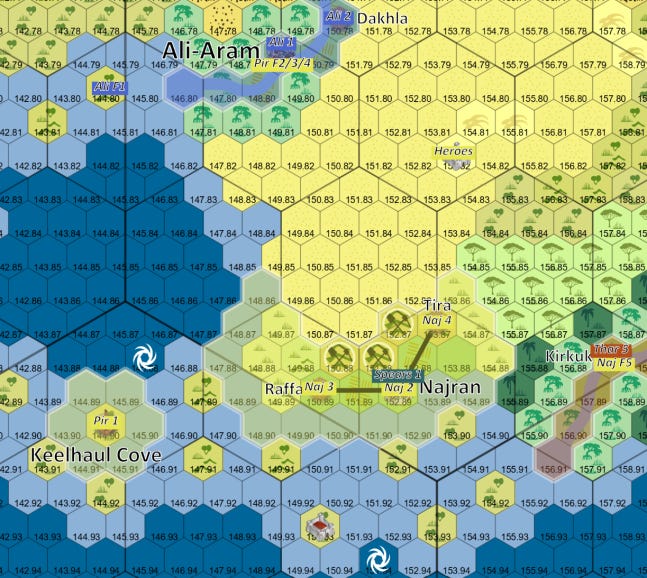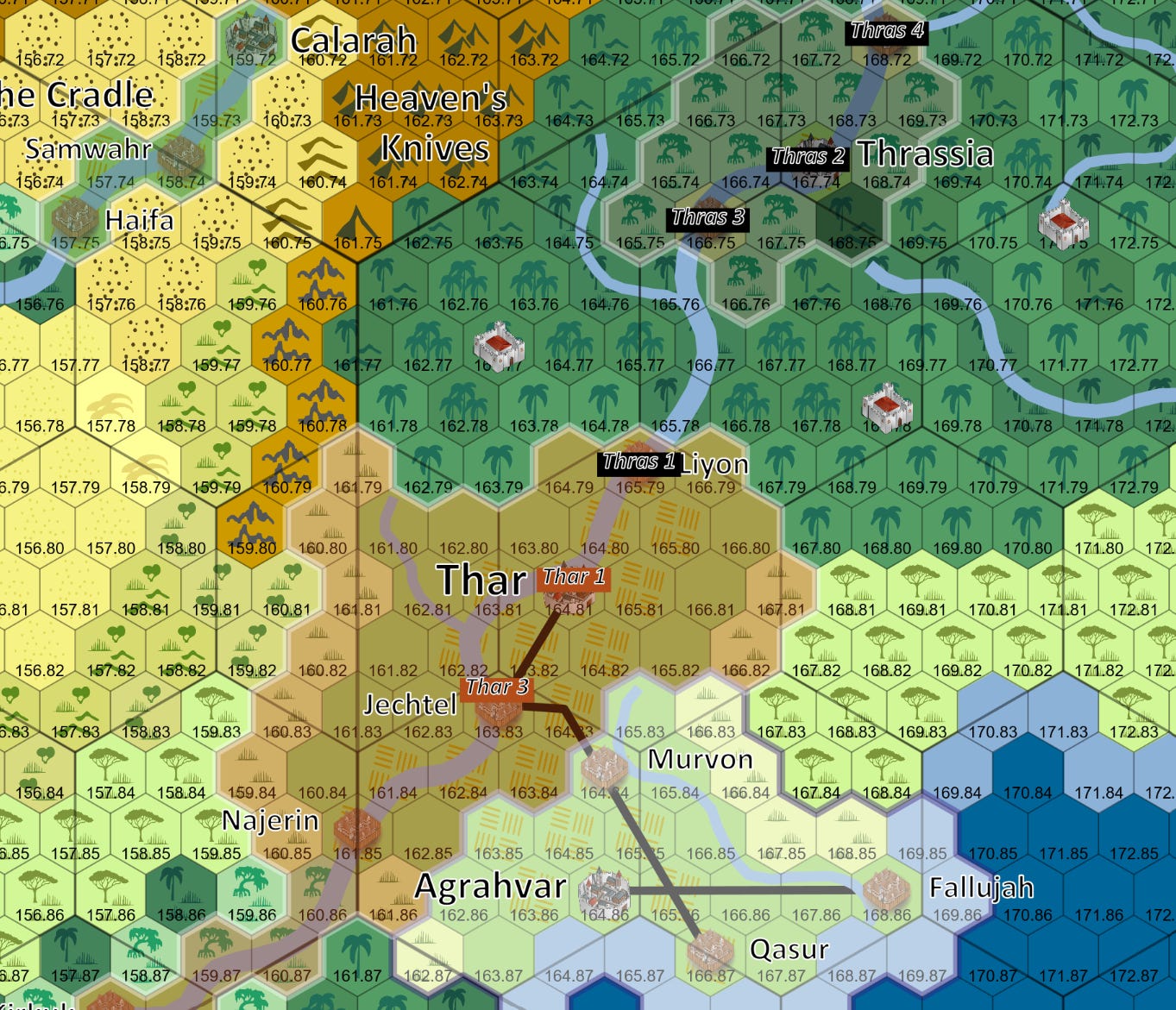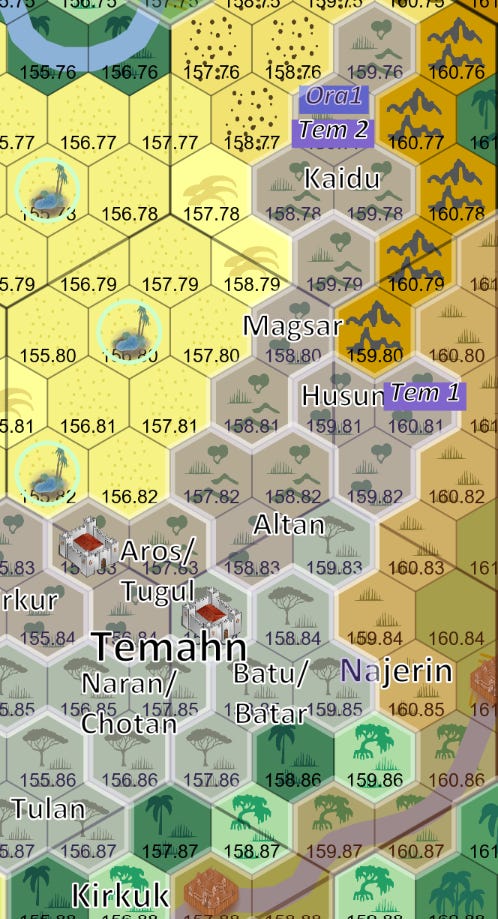This week featured a lot of maneuvering but not a lot of fighting. As well, it’s hard to catch the scope of the conversations that go on behind the scenes. The Prince of Thieves in particular seems to sells information to any and all, though he is not above tailoring it to suit his purposes. The High Priestess of Ali-Aram is seemingly still unaware that her Vizier (who I’ve presented as an NPC) is in fact his agent. It’s happened a couple times now that the Prince of Thieves has used the Vizier as a mouthpiece to give her motivating information, only for her to then turn and try to gift or sell the information back to him through another of his fronts!
The Annals of War
The Lady Lamashtu, chief lieutenant of the Caliph of Thar, now commands the defense of retaken Kirkuk and oversees the Caliph’s sorcerous apprentice as he assumes its rule and rebuilding of its walls. The Caliph’s fleet remains there as well, in standoff with the allegedly-allied Najrani fleet that just approached upriver but unwilling to initiate hostilities, while most of the Caliph’s army ventures north into the swamps to trek back on foot. It is miserable marching and slow going, and 16kgp of supplies are found infested with insects and rot — nearly the entire force’s supplies for the week ruined, and it remains unknown whether due merely to the awful environment, or more subtle enemy action.
Casting his spirit adrift in the guise of a paladin of Law, the Caliph consults the wisdom of the Empyreans, and successfully deceives them to learn that his stolen Atlas of Dominion is aboard The Mystery, which his customs officials report has just departed south from Thar. His fleet at Kirkuk sees it approaching right around the week’s end, and prepares to board it . . . no mean feat, considering it is an 8-rower superdreadnaught-class warship bristling with light trebuchets.
In Agrahvar, the Sultan continues to grow frustrated with his limited options. He would like to attack Thar, but a blatant attempt would be seen as dishonorable by his honor-bound hobgoblin mamluks and precipitate potential revolt on their part. For now, he continues to execute the Caliph’s orders with deliberate incompetence, holding position and maintaining patrols. His consistent unwillingness to reach out to or cooperate with other actors hurts him, but is basically in-character, particularly given that he’s the highest level character on his side of the map (his having outleveled the level-capped Caliph of Thar being one of the inciting events of this scenario).
The Pirate King remains infiltrated within Thar’s great field army as it marches through the swamps, and was indeed responsible for seeing its supplies ruined and the Caliph’s deep coffers depleted rather more than was expected.
His sister and other companions delve further inward into the ruined palaces of the sorcerous kings of old amidst the deep deserts, with the Sultan of Najran to guide them. A great pirate hero is gruesomely scarred, but the desired treasure is at last recovered, notably including an Amulet of Indiscernibility much-coveted by the Pirate King.
In Ali-Aram, his chief operative has gone silent, and his underlings have no knowledge of what may have happened to him. They do manage to secure a set of false uniforms of the guard of that city, in preparation for their planned coup, but without a leader that will be rather more challenging.
At Kirkuk, his Najrani fleet remains in standoff with that from Thar, and observes The Mystery come downriver at week’s end likewise, with an eye to the mounting hostilities and potential intervention, but thus far remaining uninvolved.
Thrassian armies retake Liyon, finding that despite their weeks of absence, the Caliph was cowed by their might and did not even send a garrison to reoccupy the remnants. But their scouts along the river report news that is better yet — the garrison of Thar has been reduced to less than 3000 strong, rather weaker than before.
In the city of Thrassia itself, however, the Tyrant God-King of lizardkind rages as he finds his attempted crossbreed an unstable combination that swiftly dies. At least the slaves he brought back seem to be working hard, under threat of being devoured.
In Ali-Aram, a new month means the opportunity to buy more ships, and leverage the deep treasuries of the Jewel of the South. Though her armies are slow to muster, her fleet is vast, a strong rival to any other power that seeks control of the seas. Her agents continue to search for how the pirates may be liquidating ships within her realm, but find no evidence, though one tasked with investigating the “merchant” fleet that has suspiciously lurked in port for nearly a month now notes that its captain appears missing.
The High Priestess herself begins the prayers and sacrifices that she hopes will bring a bountiful harvest, taking advantage of the libraries and workshops of her friend and client, the Maestra Nadia, who is doing her own research at the Priestess’ behest into magics of construction. Their scryings together reveal much of the state of affairs in Agrahvar.
Her Steward of the City continues to be kept in the field, clearing an island of threats so that her clients may establish a military outpost there and begin to colonize it. Her vizier observes this project continue on his mirror, and confirms the distrusted Steward’s report but notes as well no sight of Ibrahm’s three sons that were sent as well to learn and act as lieutenants.
Syed Ibrahm himself continues to sail south, slowed by a headwind to end his week almost within sight of the city of Najran. He reports increasing pirate sightings and having to scare off a modest fleet, but little else of import.
The great army of the Temahn reassembles in the lands of the eastern Agha Husun, having enjoyed their two weeks of leave and ready now once more to again march to war and plunder. Further north, a smaller detachment drives captives enslaved from the sack of Kirkuk toward a meeting with the Oracle of Theris. They are surprised to find him rather closer than expected, already amidst their lands constructing a great fortress with an army more than 12,000 strong! The Kagan was wise to send an even-tempered man, who sends a report that initiates a string of tense negotiations over this unwarranted invasion.
And last, the Prince of Thieves, whose first personal intervention has gone off without a hitch as he kidnapped the leader of the Pirate King’s force in Ali-Aram. He had not yet confirmed that anything as significant as a coup was being plotted, but his intuitions paid off, and now he holds a rather significant captive at the mercy of his interrogation.
As it is now a new month, he issues new orders to his agents, notably including three spy rings set to infiltrate the palace in Thar. He directs the High Priestess’ Vizier as well in his scrying, who was ordered to check in on her Steward of the City (which he does, largely uneventfully) and to find the secret pirate base she has come to suspect. “Secret pirate base” is rather too vague, so he picks an island on his map to check this week — and on his first try, guesses correctly! What his map shows as a modest isle of uninhabited hill-country, he finds bustling with peasants, a citadel, and a small pirate fleet. Naturally, he reports a dismal failure to the High Priestess, citing vagueness of his target, and then sells her the information through another front.
His ship The Mystery sails downriver from Thar, reaching Kirkuk by the week’s end and finding a Thari fleet arrayed in blockade against him, while a second fleet from Najran stands to spectate. His vessel is on its own a match for perhaps half the Thari fleet . . . but his vessel is on its own, and the whole Thari fleet is present here.
His mercenary company, the Spears of Heaven, enjoys some much needed time to recover in the city of Najran. By sultanic decree, they are able to recruit and replenish their ranks from across that realm, which by month’s end should correct many of their recent losses. His brigand company meanwhile continues their trek along the desert coasts to be able to deploy into the south, having taken the High Priestess’ money to leave the borders of her realm.
Reflections
Scry is an impressively powerful spell, considering that it is only 4th level — given the scope of battalion and brigade scale armies, it can be deployed en masse. The natural counter then is indiscernibility, which I had assumed would be more of an exceptional precaution for major leaders, but seems increasingly to be something that ought be spread as widely as possible. Garrison forces in particular can potentially gain additional castings of either or both via the market, which seems like a service rulers would monopolize and take great advantage of (and a good reason to have high ranking sorcerous officials in one’s entourage).
Being without indiscernibility (as the Temahn are, and the pirate forces when they’re away from the Sultan of Najran) makes it easy for rivals to observe you. Thrassia has only very limited castings, and deals with this by having a single main force with only two divisions so that it can remain entirely screened. For an NPC divine spellcaster (and to a lesser degree, as an adventurer), indiscernibility seems a top-tier choice to pick up with Syncretism.
The above, in combination with the rule that allied armies in the same 24-mile hex are grouped together for reconnaissance purposes, seems a useful constraint on the division of armies to blanket a region with small forces that might otherwise then slip through cracks and function with lower level leadership than might otherwise be required.
There is still the potential issue that a force can’t continue moving after a battle, so that tactic still works as area denial and a way to limit your losses, but I think it’s reasonable to interpret that constraint on battles and movement as a restriction against conflicts with peer forces at the same scale. The exact details I still need to work out, perhaps it would require that the advancing army be willing to fight its rival with only its vanguard, but I think there’s a good solution to be found there. In this wargame, everyone has generally kept things at battalion scale, so it hasn’t proved an issue; deployment of lots of small battalion scale armies is made infeasible by the limited number of 8th+ level commanders available.
Tonight, I’ll be sending my players the report on week seven, so I’m aiming to get the next couple reports out soonish, with more comprehensive maps than these last couple reports have managed. Stay tuned!
Addendum: wargame reports from the Intro, Week 1, Week 2, Week 3, Week 4, Week 5, Week 6, and Week 7 are all available.







